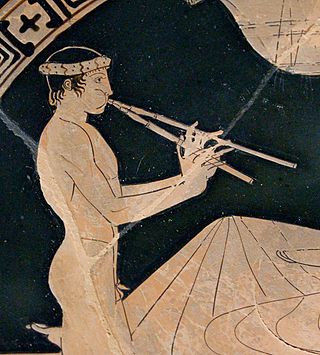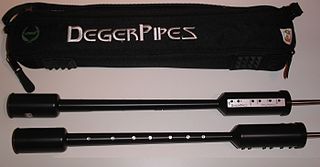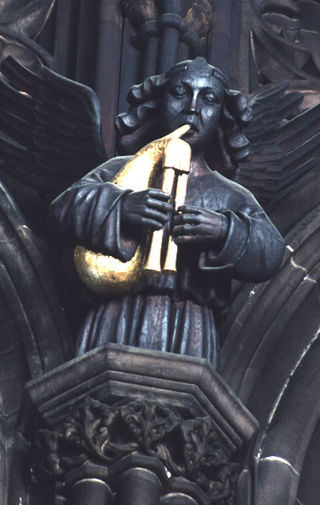Related Research Articles

Bagpipes are a woodwind instrument using enclosed reeds fed from a constant reservoir of air in the form of a bag. The Great Highland bagpipes are well known, but people have played bagpipes for centuries throughout large parts of Europe, Northern Africa, Western Asia, around the Persian Gulf and northern parts of South Asia.

The uilleann pipes, also known as Union pipes and sometimes called Irish pipes, are the characteristic national bagpipe of Ireland. Their current name is a partial translation of the Irish language terms píobaí uilleann, from their method of inflation. There is no historical record of the name or use of the term uilleann pipes before the 20th century. It was an invention of Grattan Flood and the name stuck. People mistook the term 'union' to refer to the 1800 Act of Union; however, this is incorrect as Breandán Breathnach points out that a poem published in 1796 uses the term 'union'.

The great Highland bagpipe is a type of bagpipe native to Scotland, and the Scottish analogue to the great Irish warpipes. It has acquired widespread recognition through its usage in the British military and in pipe bands throughout the world.

The Northumbrian smallpipes are bellows-blown bagpipes from Northeastern England, where they have been an important factor in the local musical culture for more than 250 years. The family of the Duke of Northumberland have had an official piper for over 250 years. The Northumbrian Pipers' Society was founded in 1928, to encourage the playing of the instrument and its music; Although there were so few players at times during the last century that some feared the tradition would die out, there are many players and makers of the instrument nowadays, and the Society has played a large role in this revival. In more recent times the Mayor of Gateshead and the Lord Mayor of Newcastle have both established a tradition of appointing official Northumbrian pipers.

An aulos or tibia (Latin) was a wind instrument in ancient Greece, often depicted in art and also attested by archaeology.
Pibroch, piobaireachd or ceòl mòr is an art music genre associated primarily with the Scottish Highlands that is characterised by extended compositions with a melodic theme and elaborate formal variations. Strictly meaning 'piping' in Scottish Gaelic, piobaireachd has for some four centuries been music of the great Highland bagpipe.

A bagpipe practice chanter is a double-reed woodwind instrument, principally used as an adjunct to the Great Highland bagpipe. As its name implies, the practice chanter serves as a practice instrument: firstly for learning to finger the different melody notes of bagpipe music, and to practice new music.

A pipe is a tubular wind instrument in general, or various specific wind instruments. The word is an onomatopoeia, and comes from the tone which can resemble that of a bird chirping.

The bladder pipe is a medieval simplified bagpipe, consisting of an insufflation tube, a bladder (bag) and a chanter, sounded by a double reed, which is fitted into a reed seat at the top of the chanter. The reed, inside the inflated bladder, is sounded continuously, and cannot be tongued. Some bladder pipes were made with a single drone pipe, and reproductions are similar to a loud, continuous crumhorn. The chanter has an outside tenon, at the top, near the reed, which fits into a socket or stock, which is then tied into the bladder.

The pastoral pipe was a bellows-blown bagpipe, widely recognised as the forerunner and ancestor of the 19th-century union pipes, which became the uilleann pipes of today. Similar in design and construction, it had a foot joint in order to play a low leading note and plays a two octave chromatic scale. There is a tutor for the "Pastoral or New Bagpipe" by J. Geoghegan, published in London in 1745. It had been considered that Geoghegan had overstated the capabilities of the instrument, but a study on surviving instruments has shown that it did indeed have the range and chromatic possibilities which he claimed.

Welsh bagpipes are a related instrument to one type of bagpipe, a chanter, which when played without the bag and drone is called a pibgorn. The generic term pibau which covers all woodwind instruments is also used in Welsh. They have been played, documented, represented and described in Wales since the fourteenth century. A piper in Welsh is called a pibydd or a pibgodwr.

The pibgorn is a Welsh species of idioglot reed aerophone. The name translates literally as "pipe-horn". It is also historically known as cornicyll and pib-corn. It utilises a single reed, cut from elder or reed, like that found in the drone of a bagpipe, which is an early form of the modern clarinet reed. The single chambered body of the elder pipe has a naturally occurring parallel bore, into which are drilled six small finger-holes and a thumb-hole giving a diatonic compass of an octave. The body of the instrument is traditionally carved from a single piece of wood or bone. Playable, extant historical examples in the Museum of Welsh Life have bodies cut and shaped of elder. Another, unplayable instrument at the Museum, possibly of a later date, is made from the leg bone of an unspecified ungulate. Contemporary instruments are turned and bored from a variety of fruitwoods, or exotic hardwoods; or turned from, or moulded in plastics. The reed is protected by a reed-cap or stock of cow-horn. The bell is shaped from a section of cow-horn which serves to amplify the sound. The pibgorn may be attached to a bag, with the additional possibility of a drone, which is then called pibau cwd; or played directly with the mouth via the reed-cap.

The electronic bagpipes is an electronic musical instrument emulating the tone and/or playing style of the bagpipes. Most electronic bagpipe emulators feature a simulated chanter, which is used to play the melody. Some models also produce a harmonizing drone(s). Some variants employ a simulated bag, wherein the player's pressure on the bag activates a switch maintaining a constant tone. As with other electronic musical instruments, they must be plugged into an instrument amplifier and loudspeaker to hear the sound. Some electronic bagpipes are MIDI controllers that can be plugged into a synth module to create synthesized or sampled bagpipe sounds.

The hornpipe can refer to a specific instrument or a class of woodwind instruments consisting of a single reed, a large diameter melody pipe with finger holes and a bell traditionally made from animal horn. Additionally, a reed cap of animal horn may be placed around the reed to contain the breath and allow circular breathing for constant play, although in many cases the reed is placed directly in the mouth. It was also known as the pibcorn, pibgorn, or piccorn. One rare Scottish example, called the stock-and-horn, is referred to by Robert Burns among others. Other hornpipes include the Spanish gaita gastoreña, the Basque alboka and the Eastern European zhaleika. When joined with a bag, Baines refers to the instruments as "bag-hornpipes".

When bagpipes arrived in England is unknown, there is some evidence to suggest Anglo-Saxon times, however the oldest confirmed proof of the existence of bagpipes anywhere in the world comes from three separate sources in the 13th century. Two of them English; the Tenison Marginalie Psalter from Westminster and an entry into the accounts books of Edward the I of England recording the purchase of a set of bagpipes. The third from the Cantigas Del Santa Maria published in Spain. From the 14th century onwards, bagpipes start to appear in the historical records of European countries, however half the mentions come from England suggesting Bagpipes were more common in England.
Hugh Robertson (1730–1822) was a Scottish wood and ivory turner and a master crafter of woodwind instruments such as pastoral pipes, union pipes, and great Highland bagpipes.
It is unclear whether Lincolnshire bagpipes refer to a specific type of pipes native to Lincolnshire, England, or to the popularity of a more general form of pipes in the region. Written records of bagpipes being associated with Lincolnshire date back to 1407, but it is difficult to find certain proof that any regional variation of the bagpipe existed which was peculiar to Lincolnshire. Despite the lack of evidence for a uniquely local instrument, it is clear that the bagpipe was enjoyed by the people of Lincolnshire.

The stock-and-horn was a traditional instrument of the Scottish peasantry, very similar to the Welsh pibgorn, consisting of a single-reed reed pipe amplified by a bell made of horn. The original instrument of the Middle Ages had a double chanter with single reeds but was replaced by the single chanter type. The single chanter instrument is described in great detail by Robert Burns in a 1794 letter to a contemporary; Burns describes how he had much difficulty coming by the instrument, and notes that it has six or seven fingerholes on the top, one on the back, and is played with a single reed unfixed to the instrument but held by the lips.
The mashak is a type of bagpipe found in Northern India, Uttarakhand, Sudurpaschim Province of Nepal and parts of Pakistan and Afghanistan. The pipe was associated with weddings and festive occasions. In India it is historically found in Kumaon and Garhwal in Uttarakhand, Rajasthan and Uttar Pradesh. This bagpipe uses single reeds, and can be played either as a drone or as a melody instrument.
References
- ↑ Barrett, William Alexander (1898). Stainer and Barrett's Dictionary of musical terms - Sir John Stainer, William Alexander Barrett - Google Books . Retrieved 2012-07-15.
- ↑ Milton, John (1874). The Lycidas and Epitaphium Damonis of Milton, ed. with notes and intr. by C ... - John Milton - Google Books . Retrieved 2012-07-15.
- ↑ Baines, Anthony; Boult, Adrian (1991-10-28). Woodwind Instruments and Their History - Anthony Baines - Google Books. ISBN 9780486268859 . Retrieved 2012-07-15.
- ↑ Dickson, Joshua (2009). The Highland Bagpipe: Music, History, Tradition - Joshua Dickson - Google Books. ISBN 9780754666691 . Retrieved 2012-07-15.